
The city of Chihuahua or Chihuahua City is the state capital of the Mexican state of Chihuahua. As of 2020, the city of Chihuahua had a population of 925,762 inhabitants. while the metropolitan area had a population of 988,065 inhabitants.
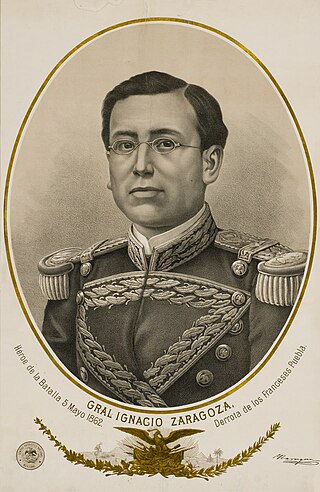
Ignacio Zaragoza Seguín was a Mexican Army officer and politician. He is best known for leading a Mexican army of 3,791 men which defeated a 5,730-strong force of French troops at the battle of Puebla on May 5, 1862 during the second French intervention in Mexico. The Mexican victory is celebrated annually as Cinco de Mayo.
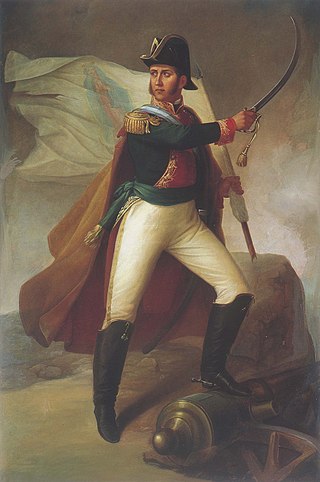
Ignacio José de Allende y Unzaga, commonly known as Ignacio Allende, was a captain of the Spanish Army in New Spain who came to sympathize with the Mexican independence movement. He attended the secret meetings organized by Josefa Ortiz de Domínguez, where the possibility of an independent Mexico was discussed. He fought along with Miguel Hidalgo y Costilla in the first stage of the struggle, eventually succeeding him in leadership of the rebellion. Allende was captured by Spanish colonial authorities while he was in Coahuila and executed for treason in Chihuahua.
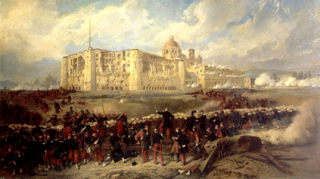
The second French intervention in Mexico, also known as the Second Franco-Mexican War (1861–1867), was a military invasion of the Republic of Mexico by the French Empire of Napoleon III, purportedly to force the collection of Mexican debts in conjunction with Great Britain and Spain. Mexican conservatives supported the invasion, since they had been defeated by the liberal government of Benito Juárez in a three-year civil war. Defeated on the battlefield, conservatives sought the aid of France to effect regime change and establish a monarchy in Mexico, a plan that meshed with Napoleon III's plans to re-establish the presence of the French Empire in the Americas. Although the French invasion displaced Juárez's Republican government from the Mexican capital and the monarchy of Archduke Maximilian was established, the Second Mexican Empire collapsed within a few years. Material aid from the United States, whose four-year civil war ended in 1865, invigorated the Republican fight against the regime of Maximilian, and the 1866 decision of Napoleon III to withdraw military support for Maximilian's regime accelerated the monarchy's collapse.
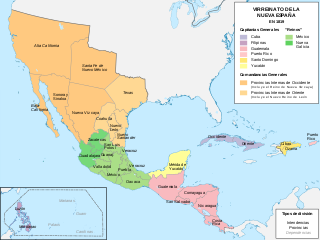
Nueva Vizcaya was the first province in the north of New Spain to be explored and settled by the Spanish. It consisted mostly of the area which is today the states of Chihuahua and Durango and the southwest of Coahuila in Mexico as well as parts of Texas in the United States.
The Battle of Santa Cruz de Rosales was an engagement of the Mexican–American War that took place after the Treaty of Guadalupe Hidalgo had been signed,the battle took place in the Town of Santa Cruz de Rosales Between the Forces commanded by the Mexican General Angel Trias Alvarez against the Forces commanded by the American General Sterling Price.
Federal Highway 2 is a free part of the Mexican federal highway corridors that runs along the U.S. border. The highway is in two separate improved segments, starting in the west at Tijuana, Baja California, on the Pacific coast and ending in the east in Matamoros, Tamaulipas, on the Gulf of Mexico. Fed. 2 passes through the border states of Baja California, Sonora, Chihuahua, Coahuila, Nuevo Leon and Tamaulipas. It has a total length of 1,987 kilometres (1,235 mi); 1,343 kilometres (835 mi) in the west and 644 kilometres (400 mi) in the east.

The Provincias Internas, also known as the Comandancia y Capitanía General de las Provincias Internas, was an administrative district of the Spanish Empire created in 1776 to provide more autonomy for the frontier provinces of the Viceroyalty of New Spain, present-day northern Mexico and the Southwestern United States. The goal of its creation was to establish a unified government in political, military and fiscal affairs. Nevertheless, the Commandancy General experienced significant changes in its administration because of experimentation to find the best government for the frontier region as well as bureaucratic in-fighting. Its creation was part of the Bourbon Reforms and was part of an effort to invigorate economic and population growth in the region to stave off encroachment on the region by foreign powers. During its existence, the Commandancy General encompassed the provinces of New Navarre, New Biscay, The Californias, New Mexico, New Santander, New Kingdom of Leon, Coahuila and Texas.
Santa Cruz de Rosales is a town and seat of the municipality of Rosales, in the northern Mexican state of Chihuahua. As of 2010, the town had a population of 5,570, up from 5,377 as of 2005
Federal Highway 16 is a free part of the federal highways corridors of Mexico.
Federal Highway 49 (Fed. 49) is a free (libre) part of the federal highways corridors of Mexico. The highway runs northwest-southeast in the western regions of the Mexican Plateau.

Sebastián is a Mexican sculptor best known for his monumental works of steel and/or concrete in both Mexico and abroad. These include a number of “gate” sculptures such as the Gran Puerta a México in Matamoros, Tamaulipas but his most famous sculpture is the “Caballito” located in downtown Mexico City. His works are found in various countries outside Mexico, such as Japan where two are now used as city symbols.

Chihuahua, officially the Free and Sovereign State of Chihuahua, is one of the 31 states which, along with Mexico City, comprise the 32 federal entities of Mexico. It is located in the northwestern part of Mexico and is bordered by the states of Sonora to the west, Sinaloa to the southwest, Durango to the south, and Coahuila to the east. To the north and northeast, it shares an extensive border with the U.S. adjacent to the U.S. states of New Mexico and Texas. The state was named after its capital city, Chihuahua City; the largest city is Ciudad Juárez. In 1864 the city of Chihuahua was declared capital of Mexico by Benito Juarez during the Reform War and French intervention. The city of Parral was the largest producer of silver in the world in 1640. During the Mexican War of Independence, Miguel Hidalgo was executed on July 30, 1811, in Chihuahua city.
Ignacio Asúnsolo (1890–1965) was a Mexican sculptor trained in France.

The Battle of San Pedro was fought between the French and Mexican imperial forces and the Mexican Republicans during the Second French intervention in Mexico on 22 December 1864. The liberals achieved a decisive victory over the invading forces and captured the majority of the survivors.
Luis Y. Aragón is a Mexican painter and sculptor, best known for his sculpted mural work, as well as the design of the Gawi Tonara award which is given by the state of Chihuahua. His mural work can be found in various parts of Mexico, especially his home state of Chihuahua and Mexico City. His work has been exhibited in Mexico and abroad, generally in the Americas and Europe. He is a member of the Salón de la Plástica Mexicana and works in Mexico City.
The Battle of Chihuahua or Recapture of Chihuahua City took place on March 24, 1866, in Chihuahua City, in Chihuahua State, Mexico, between elements of the Mexican Army of the Republic, led by Colonel Luis Terrazas, and French and Mexican troops in the service of the Second Mexican Empire during the Second French intervention in Mexico. The attack on Chihuahua City was launched by the Republicans at 9 am against the imperial occupying forces, resulting in an imperial surrender of the city two hours later.

The Our Lady of Guadalupe Cathedral, also Ciudad Juárez Cathedral, is a Catholic cathedral church dedicated to the Virgin of Guadalupe that is located in Ciudad Juárez in the border state of Chihuahua, in Mexico, in the area called Historical Center. It was built in the middle of the second half of the twentieth century and is attached to the old and still preserved Franciscan mission, founded in the 17th century, in the then Paso del Norte.
María Elisa Martiniana Griensen Zambrano, known as Elisa Griensen was a Mexican patriot who fought against the army of the United States during the Pancho Villa Expedition.
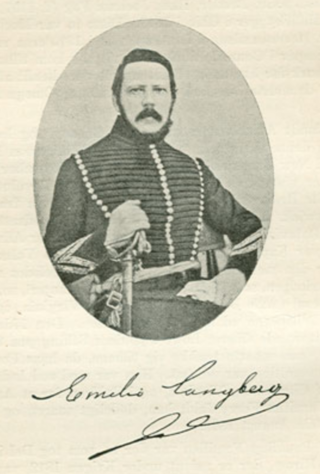
Edvard Emile Langberg (1810-1866) also known in Spanish as Emilio Langberg was a Danish-Mexican general who served in Mexico's military during the mid 19th-Century. He participated in the various coups that the government experienced in the era, and defended his adopted country during the Mexican American War. During the War of Reform, he fought on the side of the liberals, and during the Second French Intervention in Mexico he joined the Second Mexican Empire and was eventually killed in action during the Battle of Guadeloupe in Ures, Sonora.










